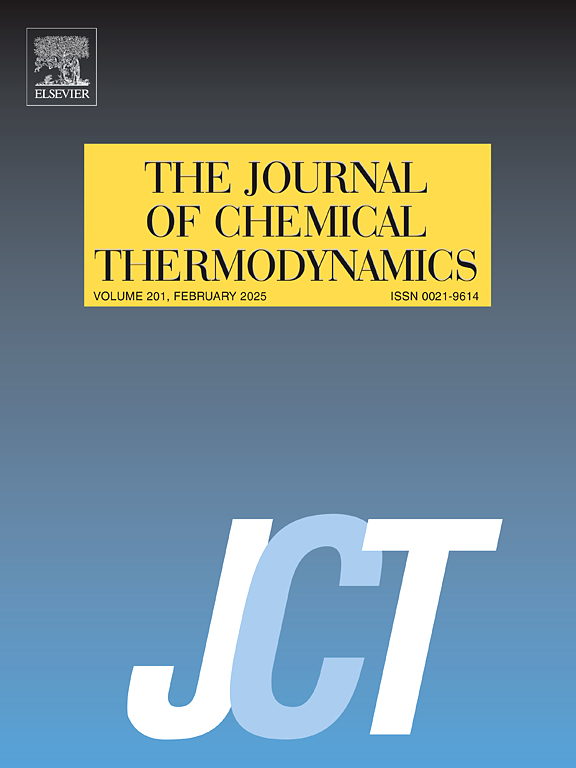A simplified method for enhanced accuracy in calculating adsorption thermodynamic parameters
IF 2.2
3区 工程技术
Q3 CHEMISTRY, PHYSICAL
引用次数: 0
Abstract
This study investigates the thermodynamic parameters of phosphate adsorption on activated carbon using the Pitzer ion-interaction model. The adsorption data were analyzed using the Langmuir and Sips models, both providing satisfactory fits. Maximum adsorption (plateau) occurred at an equilibrium phosphate concentration of 60.8 mmol⋅ dm−3 (pH = 5.1), with an adsorption capacity of 7.03 mmol⋅g−1. The Pitzer model was used to calculate the activity coefficient of phosphates, considering the influence of all ions in the solution on the adsorption plateau. The maximum degree of dissociation of H₂PO₄-(aq) ions was determined to be xd(2) = 0.0026, taking hydrolysis into account. The activity coefficient of KH₂PO₄ in the mixed solution {K₂HPO₄ + KH₂PO₄ + H₃PO₄}(aq) was found to be γ± = 0.7788, while in a pure KH₂PO₄ solution at the same ionic strength corresponding to the plateau, it is γ± = 0.7790. Given the minor difference in activity coefficient, the mixed solution could be approximated as a pure KH₂PO₄(aq) for thermodynamic analysis, which greatly simplified the calculations. The Gibbs free energy was ΔGL = − 8.6200 ± 0.0004 (kJ⋅mol−1) using the Langmuir equilibrium constant shifting to ΔGa = − 9.240 ± 0.006 (kJ⋅mol−1) when accounting for activity coefficient and the thermodynamic equilibrium constant. With the Sips model, the Gibbs free energy was ΔGS = − 9.620 ± 0.004 (kJ⋅mol−1) and further refinement using phosphate activity coefficient gave ΔGa = −10.235 ± 0.007 (kJ⋅mol−1). The absolute differences in adsorption energy were approximately 7 % (Langmuir) and 6 % (Sips), highlighting the importance of considering ionic activities.

一种提高吸附热力学参数计算精度的简化方法
采用Pitzer离子相互作用模型研究了活性炭吸附磷酸盐的热力学参数。采用Langmuir模型和Sips模型对吸附数据进行了分析,两者的拟合结果都令人满意。磷酸盐平衡浓度为60.8 mmol⋅dm−3 (pH = 5.1)时吸附量最大,吸附量为7.03 mmol⋅g−1。考虑溶液中各离子对吸附平台的影响,采用Pitzer模型计算磷酸盐的活度系数。考虑水解作用,确定H₂PO₄-(aq)离子最大解离度为xd(2) = 0.0026。在混合溶液(K₂HPO₄+ KH₂PO₄+ H₃PO₄)中,KH₂PO₄的活度系数(aq)为γ±= 0.7788,而在离子强度相同的纯KH₂PO₄溶液中,其活度系数为γ±= 0.7790。由于活度系数相差不大,混合溶液可以近似为纯KH₂PO₄(aq)进行热力学分析,大大简化了计算。考虑活度系数和热力学平衡常数,使Langmuir平衡常数变为ΔGa =−9.240±0.006 (kJ·mol−1),Gibbs自由能为ΔGL =−8.6200±0.0004 (kJ·mol−1)。在Sips模型下,Gibbs自由能为ΔGS =−9.620±0.004 (kJ·mol−1),利用磷酸活度系数进一步精化得到ΔGa =−10.235±0.007 (kJ·mol−1)。吸附能的绝对差异约为7% (Langmuir)和6% (Sips),突出了考虑离子活性的重要性。
本文章由计算机程序翻译,如有差异,请以英文原文为准。
求助全文
约1分钟内获得全文
求助全文
来源期刊

Journal of Chemical Thermodynamics
工程技术-热力学
CiteScore
5.60
自引率
15.40%
发文量
199
审稿时长
79 days
期刊介绍:
The Journal of Chemical Thermodynamics exists primarily for dissemination of significant new knowledge in experimental equilibrium thermodynamics and transport properties of chemical systems. The defining attributes of The Journal are the quality and relevance of the papers published.
The Journal publishes work relating to gases, liquids, solids, polymers, mixtures, solutions and interfaces. Studies on systems with variability, such as biological or bio-based materials, gas hydrates, among others, will also be considered provided these are well characterized and reproducible where possible. Experimental methods should be described in sufficient detail to allow critical assessment of the accuracy claimed.
Authors are encouraged to provide physical or chemical interpretations of the results. Articles can contain modelling sections providing representations of data or molecular insights into the properties or transformations studied. Theoretical papers on chemical thermodynamics using molecular theory or modelling are also considered.
The Journal welcomes review articles in the field of chemical thermodynamics but prospective authors should first consult one of the Editors concerning the suitability of the proposed review.
Contributions of a routine nature or reporting on uncharacterised materials are not accepted.
 求助内容:
求助内容: 应助结果提醒方式:
应助结果提醒方式:


